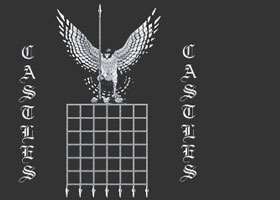History of Stone Medieval Round Castle Keeps
The history of the Medieval Castles moved on. Square towers were replaced with round towers. The walls were thicker and a drawbridge was introduced. Problem - the Motte (mound) on which the castles were built could not easily bear the weight of a solid stone tower. The history of the Medieval castles moved on to the introduction of Shell Castle Keeps ... History of Norman Stone Medieval Round and Shell Castle Keeps
The history of the Medieval Castles moved on. The Medieval Shell castle keep was developed because the motte (mound) on which the castles were built could not bear the weight of a solid stone tower. The shell castle keep was created by building a stone wall which completely surrounded the upper part of the motte (mound), . These types of 'Shell' keeps were hollow and distributed the weight. The Medieval Shell castle keep walls were strengthened by the addition of wall towers and buttresses. Problem - the Castle Keep needed more defence! King Edward I intended to conquer Wales! He needed bigger castles and wanted fortified towns attached to the castles to provide a power and trading base for his English Invaders! The history of the Medieval castles moved on to the introduction of Concentric Castles ... History of Medieval Concentric Castles
The history of the Medieval Castles moved on. The Medieval Concentric castle was developed as a means to subjugate the Welsh. These castles were really massive! They consisted of lots of buildings, not just one Keep. The concentric castle walls surrounded the new towns that were built. The chain of Medieval Concentric castles enabled the English King to conquer Wales forever. Medieval Concentric Castles were also built to subjugate the Scots. King Edward I did not quite succeed but he was still given the title 'hammer of the Scots'. Problem - the concentric castles were really expensive to build. King Edward had effectively bankrupted England with his Concentric castles! The Plantagenet Kings who followed King Edward made good use of the castles he had built. The welsh had been conquered, the Scots were still troublesome but new castles built had a different look and purpose. And the Medieval architects and builders discovered the amazing strength and stability of using pointed arches. The history of the Medieval castles moved on to the introduction of Gothic Architecture and a new look for Medieval castles... History of Medieval Gothic Castles
The history of the Medieval Castles moved on. The walls of Gothic castles could be thinner because the weight of the roof was supported by the arches rather than the walls. The use of the Gothic arch gave the builders tremendous flexibility. The arch could not only support greater weights but could also could span greater distances, allowing vaults to be taller and wider. Thinner walls had wider window openings which encouraged the use of stained glass and the magnificent Gothic Rose Windows. Medieval castles were becoming more comfortable! Problem! Time had moved on to the Tudor era and the English were very nervous of the possibility of another French or even Spanish Invasion. England needed more defence! The history of the Medieval castles moved on to the introduction of the Tudor Coastal Forts... History of Medieval Tudor Coastal Forts
The history of the Medieval Castles moved on. Coastal Forts were built. England was safe from invasion! The next castles were required to be more luxurious - comfort was the key as opposed to defence. Palaces were built and the long history of Medieval Castles came to an end! | 
